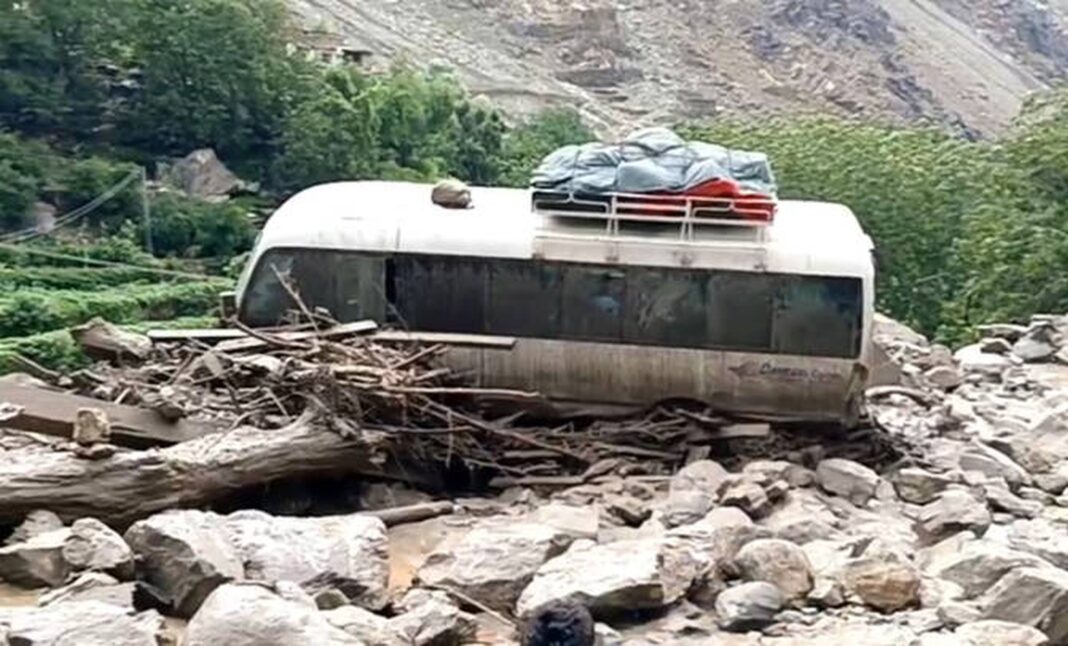“I went to Chakwal to interview people about how their lives were being affected by climate change. While I was there, the weather suddenly changed, and it rained heavily, 443 mm, which was the highest recorded rainfall. A few days later, it rained in Islamabad, and Saidpur village was badly hit by urban flooding, said to be caused by a cloudburst.
My own area, near the Margalla Hills, was also drowned in rain. It came down so fast that in minutes, water was up to my knees. Roads were blocked, whole areas were cut off, the River Sawan flooded, and the Nullah Lai in Rawalpindi overflowed.
This kind of urban flooding is terrifying for ordinary people because unplanned constructions and housing societies block natural water flow and push the flood into homes and streets. That night, I was stuck outside until 12:30 a.m. and only made it home with the help of friends.
I had interviewed many people about climate change, but this was the first time I experienced it myself. Now I truly know what it feels like,” recalls Saadeqa Khan, Editor-in-Chief of Scientia Magazine.
Her experience reflects what millions across Pakistan are now facing as climate disasters escalate. The helplessness of people in these moments is beyond words. It is no longer just the rural communities, like those devastated by the 2022 floods, who are at risk. This time, the floodwaters have reached the cities, threatening the very core of Pakistan.
As Anatol Lieven writes in Pakistan: A Hard Country, “In the long run, the greatest threat to Pakistan’s existence is not insurgency, but ecological change.” He was not wrong.
The numbers from 2022 alone reveal the scale of devastation. That year’s floods displaced eight million people, killed more than 1,700, and injured over 13,000. Yet despite disasters of this magnitude repeating year after year, serious measures to prepare for and mitigate such crises remain largely absent. The pattern has not changed but has intensified three years later.
By mid-July 2025, relentless monsoon rains and flash floods had already claimed 163 lives across the country. The Twin Cities and several districts of Punjab, including Chakwal and Babusar Top in KPK, were submerged by sudden cloudbursts, with entire neighborhoods drowning in a matter of hours.
Survivors in remote areas are left with invisible wounds that rarely heal. For families who have lost everything, survival inevitably takes precedence over therapy or counseling.
Pakistan contributes less than one percent to global carbon emissions, yet it ranks as the eighth most vulnerable country in the world to climate-related disasters, according to the Climate Risk Index (UNDP, n.d.). The injustice is stark. Those who contribute the least to the crisis are the ones who pay the heaviest price. Part of the reason lies in Pakistan’s geography. Its vast network of glaciers, which feed the Indus River, is melting at unprecedented rates. These overfilled rivers fuel destructive flash floods, while ever-intensifying heat waves, driven by global greenhouse gas emissions, kill hundreds each year (Energy Tracker Asia, n.d.).
Adding to this, cloudbursts, once rare, are now becoming more frequent in Pakistan. Warmer temperatures caused by climate change increase the amount of moisture the air can hold, and when this moisture is suddenly released, it triggers intense downpours within a short span, overwhelming drainage systems and natural waterways. The result is instant, destructive flooding in both rural and urban landscapes.

We all saw the tragedy in DHA, where a father and daughter were swept away in the floods. They were seen waving and calling for help, yet no one could save them. One video that spread rapidly online showed a family standing on a rock in the middle of a river in Swat, reportedly to take photographs, when a sudden surge of floodwaters swept them away within seconds. It left millions of Pakistanis asking themselves the same haunting question: Are we ever truly safe, even in our own homes?
These “what ifs” echo in the minds of survivors and witnesses alike, planting seeds of fear and lasting mental distress. For rural families, the toll is even heavier. Elderly people and children, already the most vulnerable, face a lifetime of anxiety and grief. They lose not just their homes but also the very sense of security that anchors their lives. Many can only ask themselves in despair: Where do I go now? Everything is gone. My farm, my cattle, and my children are scattered. I no longer even have a home to return to.
The voices of survivors reveal the human cost more than any number ever could. Obaidullah, a survivor of the 2022 floods, recalls the day he was stranded on a rock as floodwaters raged around him. One by one, his friends were swept away before his eyes. Villagers risked their lives to pull him to safety with ropes, but the memory still haunts him. “It was very painful to see that I couldn’t do anything for my friends”, he told Al Jazeera, his voice breaking as he relived the moment.
Another victim, Rustam, an 80-year-old farmer, described the despair he felt during the same floods. “There were extreme rains, and some people informed us about the surprise flooding. We did not know where to go. Our villagers took me with them to a safe place. It was like I had already died, and people were dragging me there, as I am blind. There was around five feet of water in our home at that time. This flood was like doomsday. Our lands, houses, and everything else got destroyed.” (ShelterBox, n.d.).
Asif Shehzad, another victim, spoke about how unrelenting rains destroyed his home and livelihood. “It rained like I had never seen before in my life. Some livestock died when the roof collapsed. We feared the whole house would fall, so we took refuge under trees. Since that day, we have been living under the open sky. The disease has spread. My children have no medicine, no help. I don’t know what I will do if they fall sick.” (Al Jazeera, 2022).
These stories echo the fear and devastation faced by millions. They also underline a haunting reality: as climate change accelerates, those who contribute least to the crisis will continue to suffer the most, left to rebuild their shattered lives with little support and no certainty about what disaster will come next.
But the damage left behind is not just physical. For many survivors, the fear does not end when the floodwaters recede. The trauma lingers in sleepless nights, in the constant fear of another disaster, in the grief of losing loved ones, homes, and livelihoods. This invisible suffering is rarely acknowledged, yet it is as real as the destruction itself.
In Pakistan, mental health is rarely part of disaster relief. Limited resources and a fragile healthcare system mean psychological support, when available, is confined mostly to large cities. Survivors in remote areas are left with invisible wounds that rarely heal. For families who have lost everything, survival inevitably takes precedence over therapy or counseling.
This is even though nearly 78 percent of adults with mental health conditions in Pakistan remain untreated, with rates even higher for children. When outbreaks of waterborne diseases and deadly heat strokes still go under-addressed after such disasters, mental health is left at the very bottom of the list.
Their voices, often drowned out by statistics, remind us that these disasters are no longer rare events but a recurring reality. They also highlight a deeper injustice. Pakistan stands on the frontlines of a crisis it did not create, yet the world offers far too little support, and domestic efforts to prepare for future floods and heatwaves remain slow and insufficient. Without urgent action from both the international community and Pakistan’s leadership, millions will continue to pay the price for a climate crisis they did little to cause.
Climate financing, disaster-resilient infrastructure, and accessible mental health services are not luxuries. They are matters of survival. The waters will rise again. The only question is whether we will be ready, or whether we will once again leave the most vulnerable to face the next deluge alone.
References:
- Al Jazeera. (2022, August 30). Non-stop rains leave families homeless and stranded in Pakistan. Al Jazeera. https://www.aljazeera.com/news/2022/8/30/non-stop-pakistan-rains-leave-families-homeless-stranded
- BBC News. (2022, September 2). Pakistan floods: Climate change made rainfall up to 50% more intense. BBC. https://www.bbc.com/news/science-environment-62758811
- Energy Tracker Asia. (n.d.). Heat wave in Pakistan: A warning the world can’t ignore. Retrieved July 24, 2025, from https://energytracker.asia/heat-wave-in-pakistan/
- United Nations Development Programme (UNDP). (n.d.). Climate Promise II: Supporting Pakistan’s climate action. Retrieved July 24, 2025, from https://www.undp.org/pakistan/projects/climate-promise-ii
- (n.d.). Rustam’s story. Retrieved July 24, 2025, from https://shelterbox.org/impact/rustams-story/
More from the author: Failing Science in Pakistani Schools— Punishing Curiosity and Encouraging Rote Learning

Zoha Imran is an undergraduate physics student from Peshawar with a strong passion for quantum information sciences. Zoha is dedicated to making science more accessible through her writings. She dives deep into quantum mechanics and enjoys exploring new ideas. She loves reading and expanding her knowledge on a variety of subjects.”

